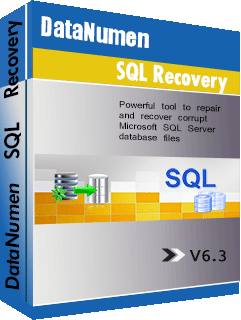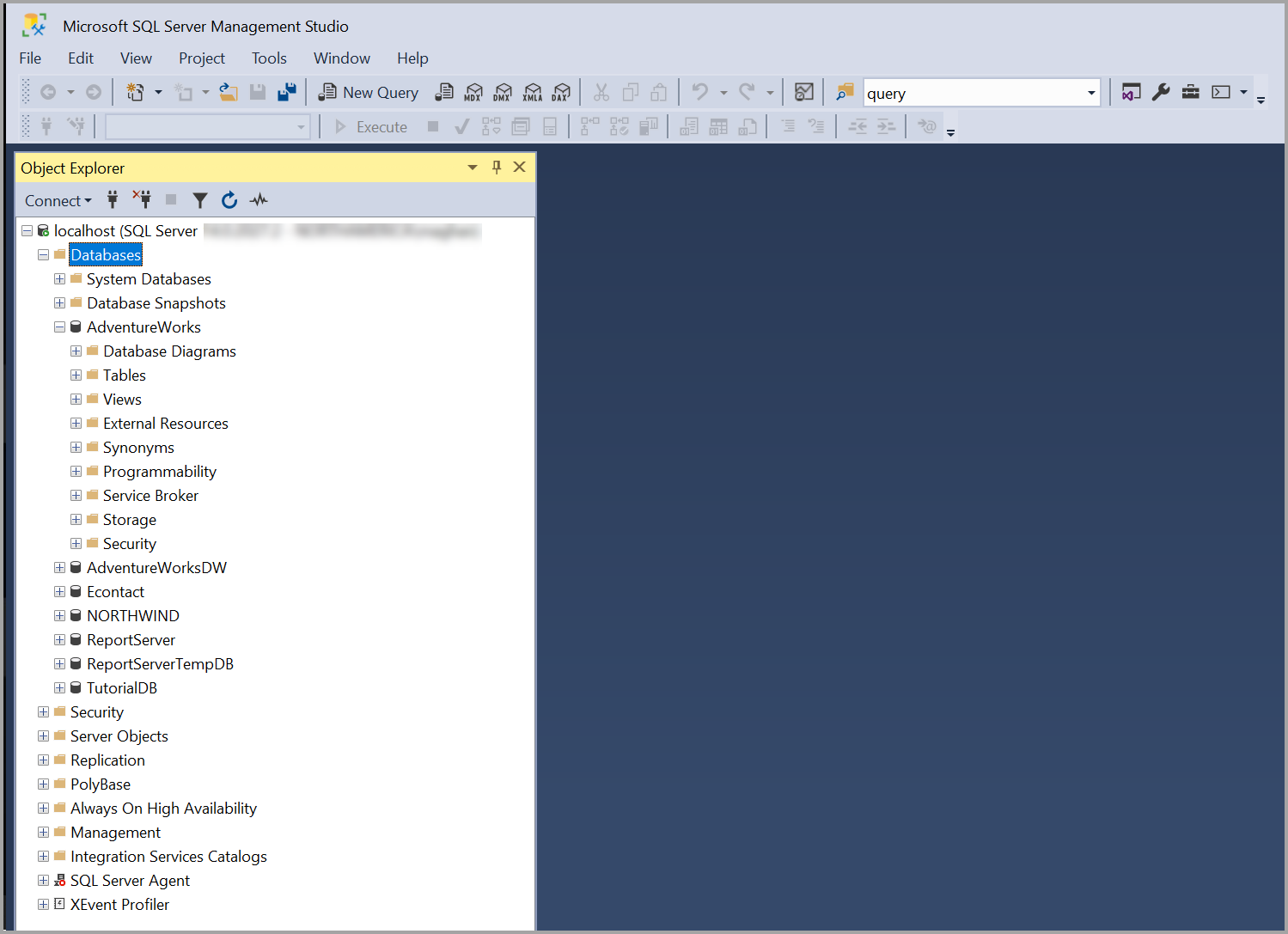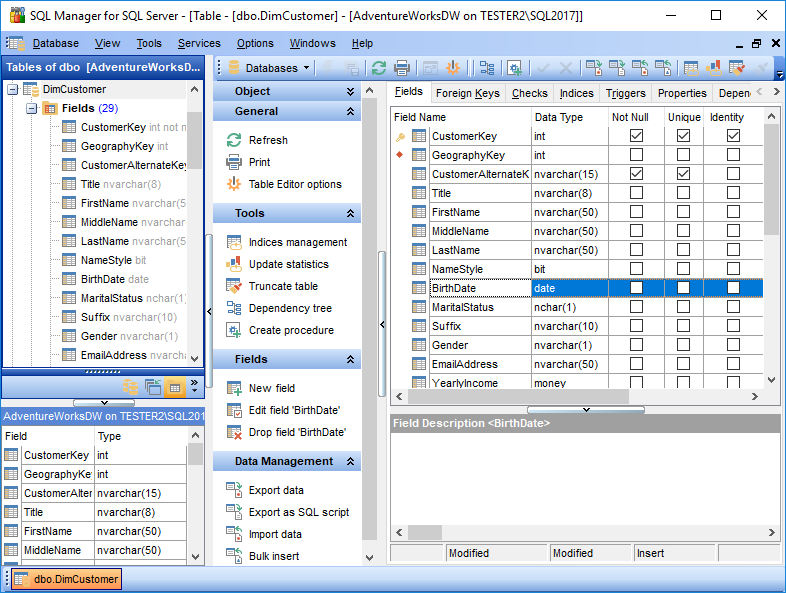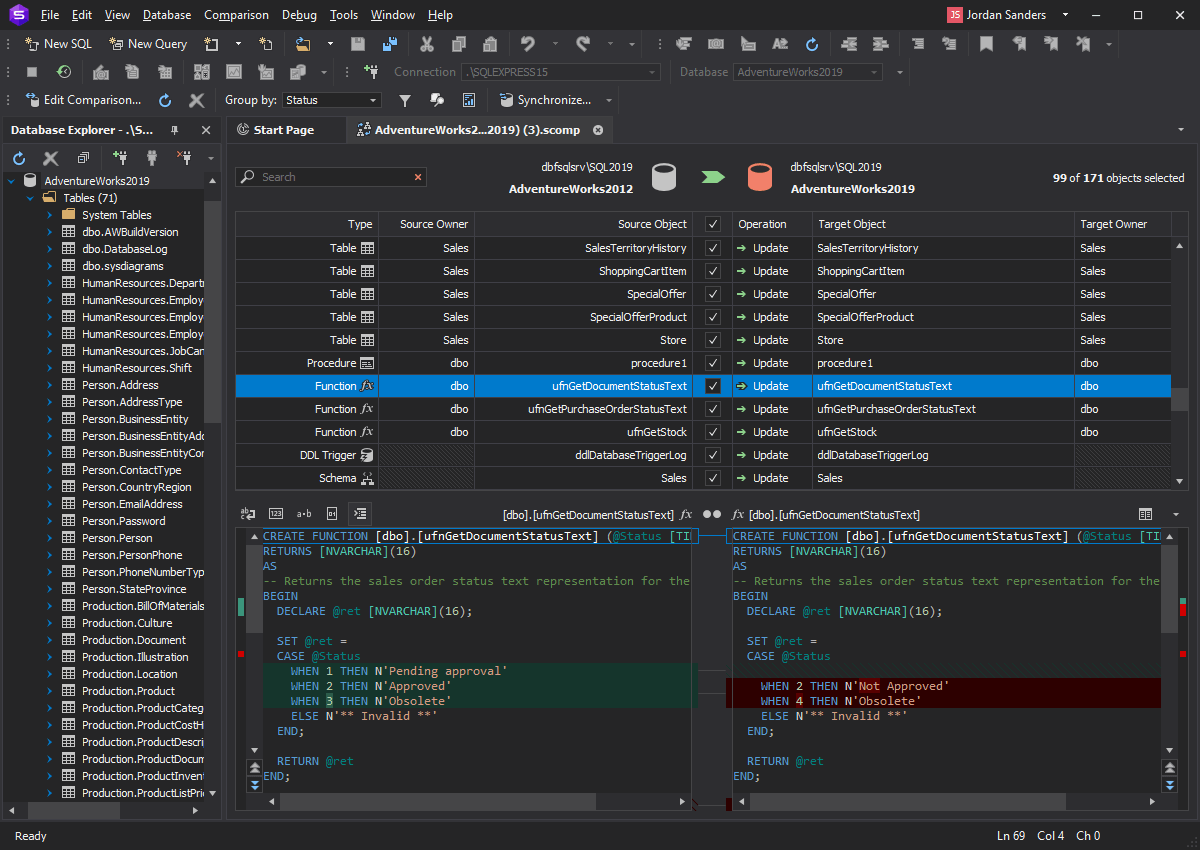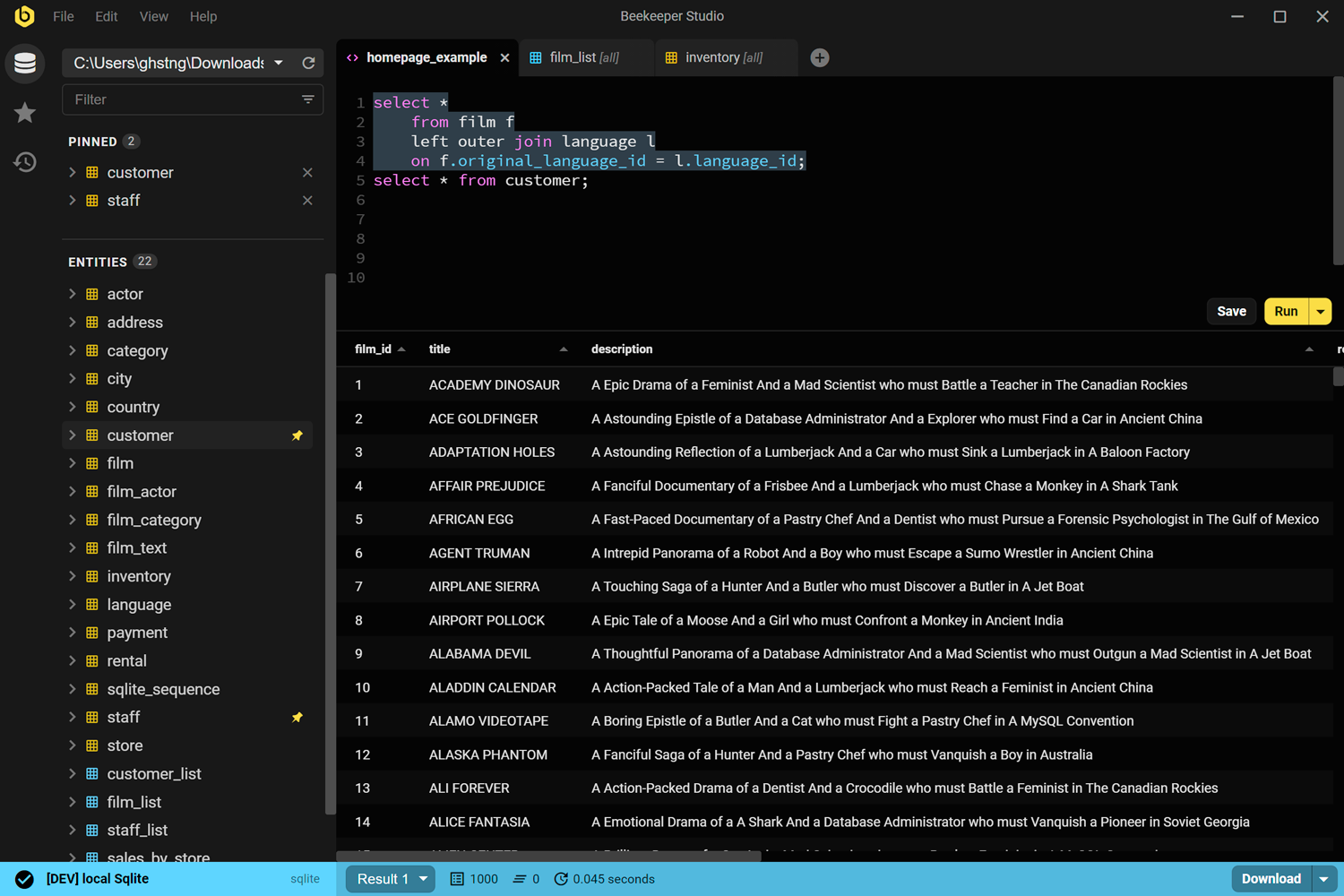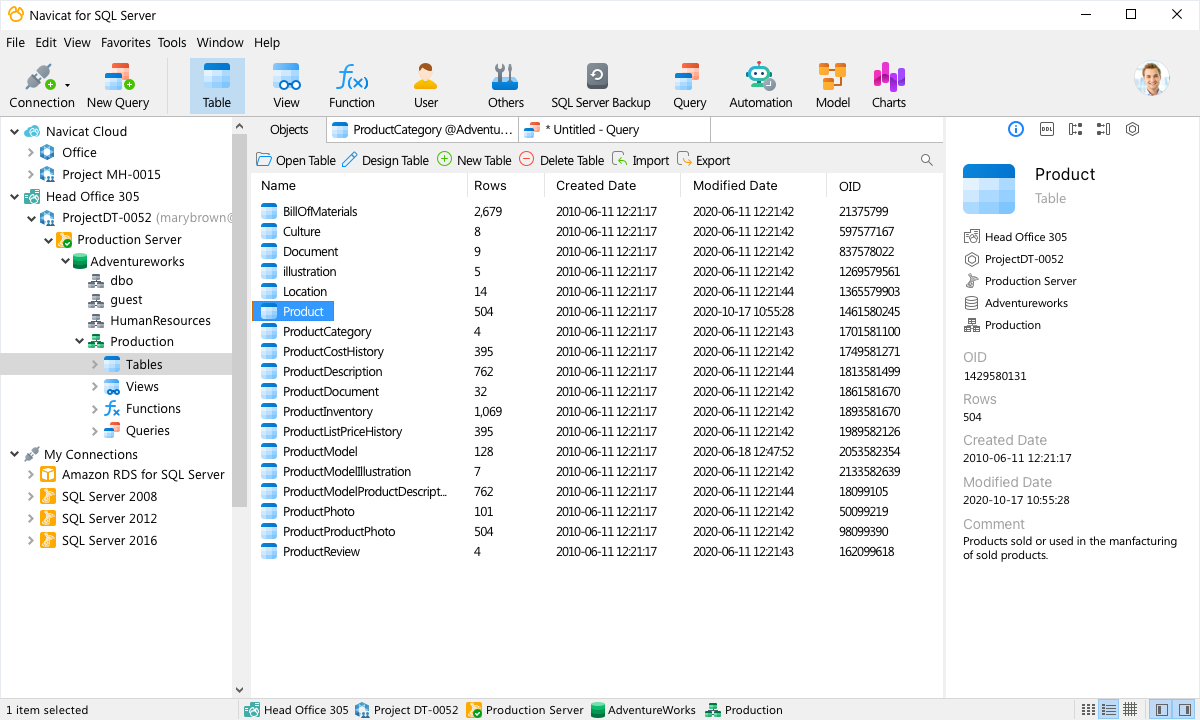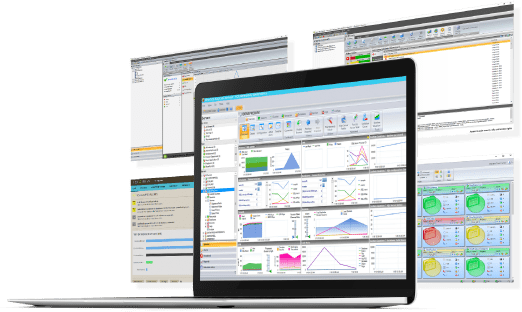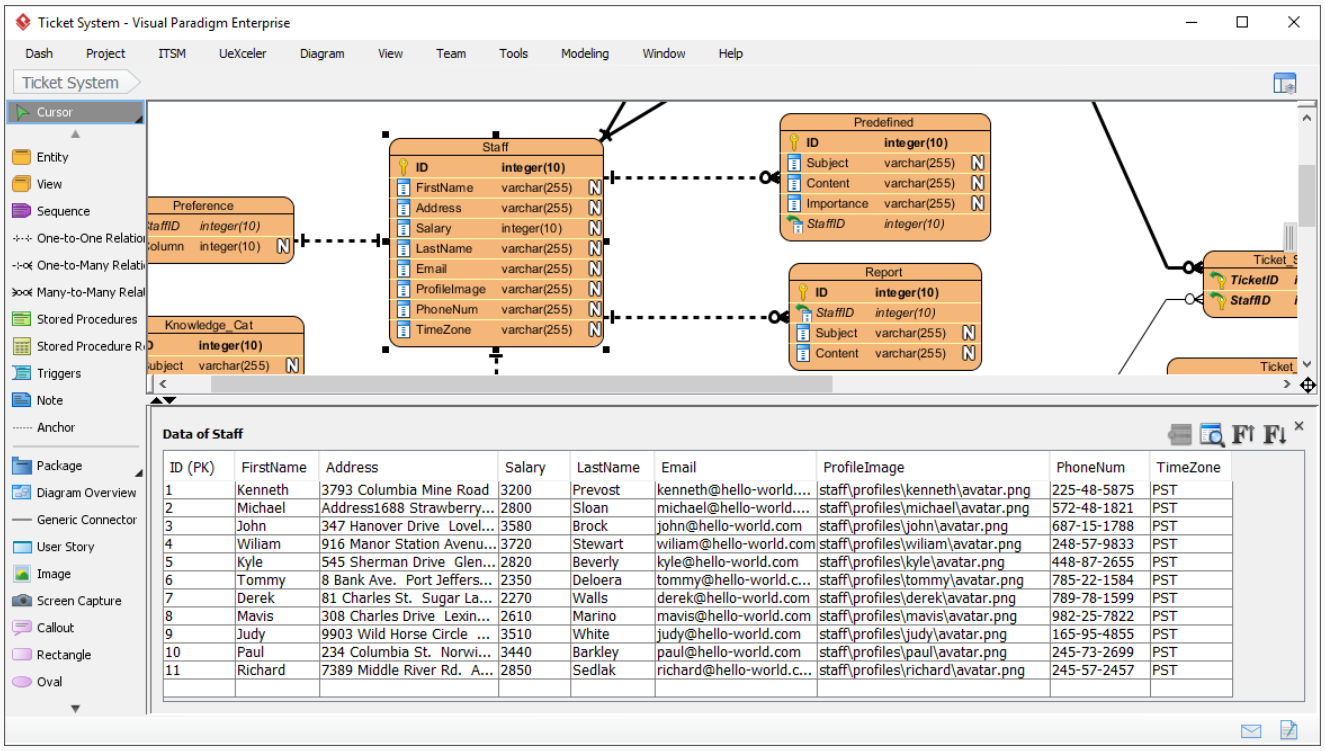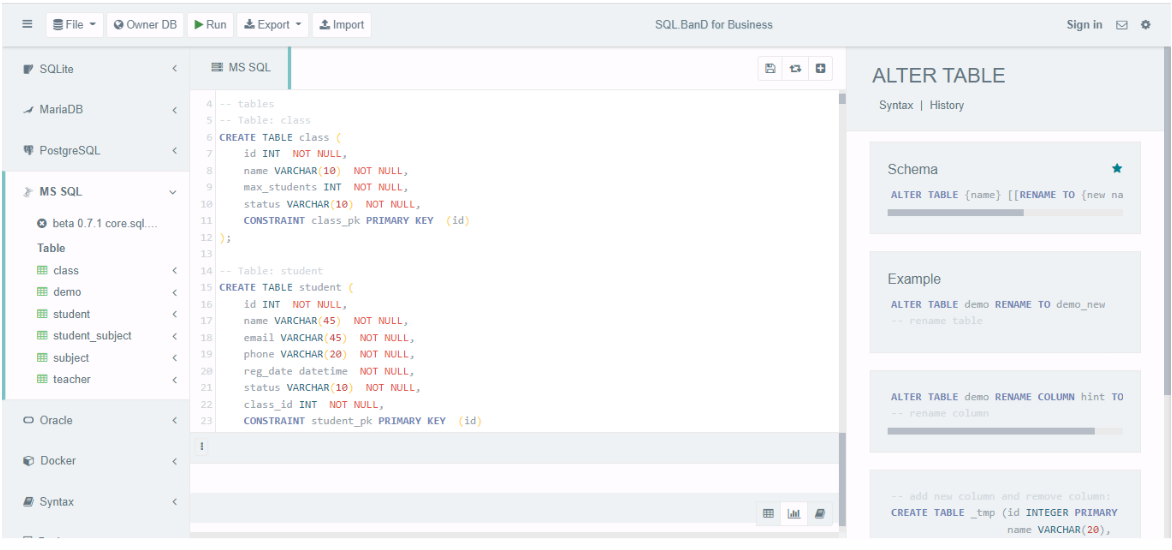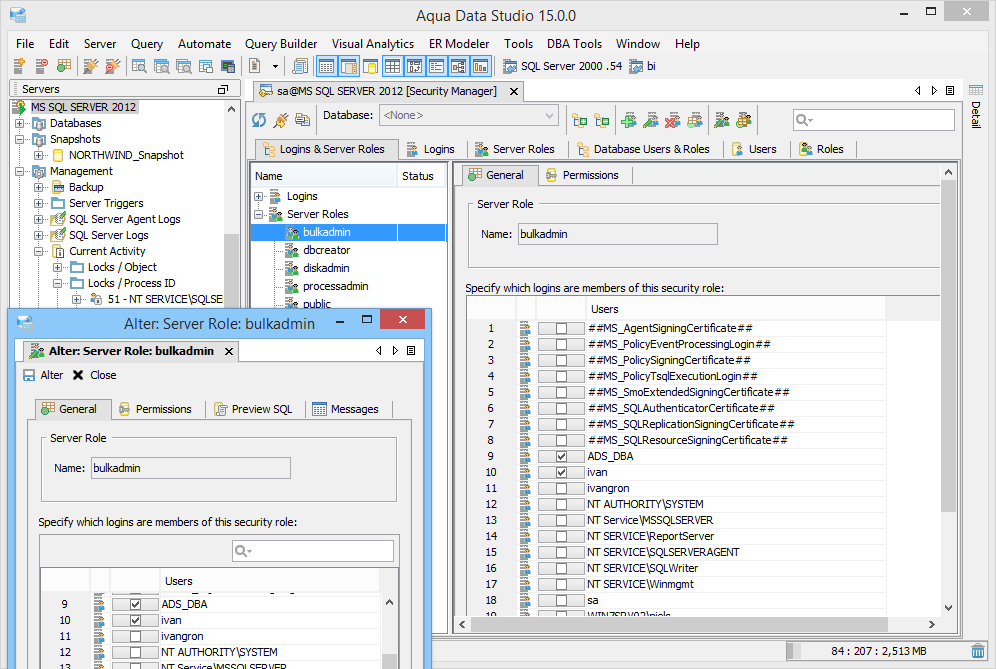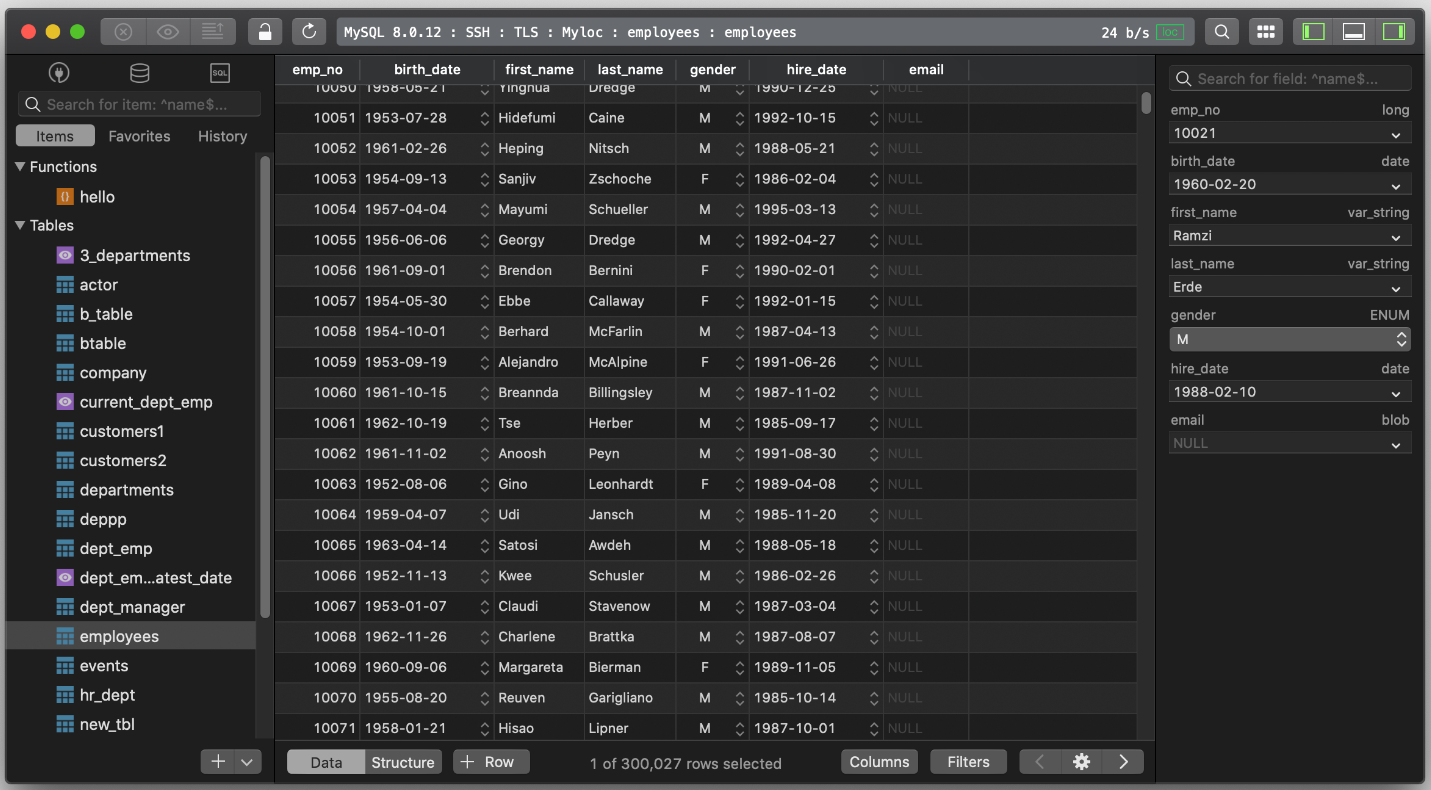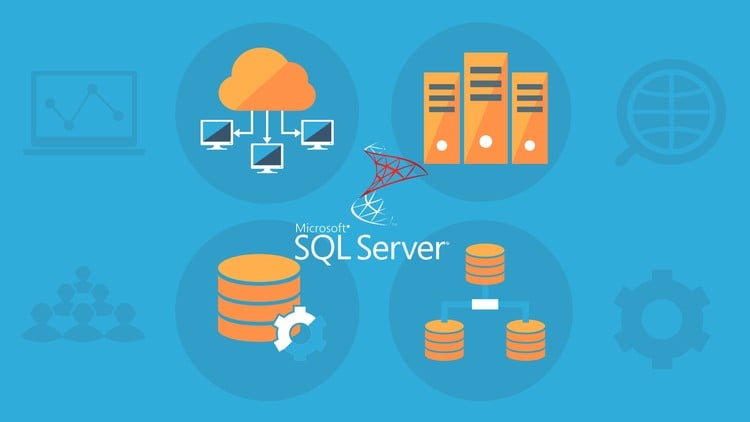1. Introduction
1.1 Importance of SQL Server Management tool
Managing data effectively and efficiently is a crucial aspect of any business today. Database Management Systems (DBMS), such as SQL Server, have become an indispensable part of modern technology infrastructure. Specifically, SQL Server Management Tools play a pivotal role in handling all administrative tasks such as configuration, error logging, back-up, data encryption, performance monitoring, job scheduling, and more. These tools not only ensure optimal performance of your database systems but also enhance the workflows by allowing administrators and developers to prioritize tasks and troubleshoot issues in real-time.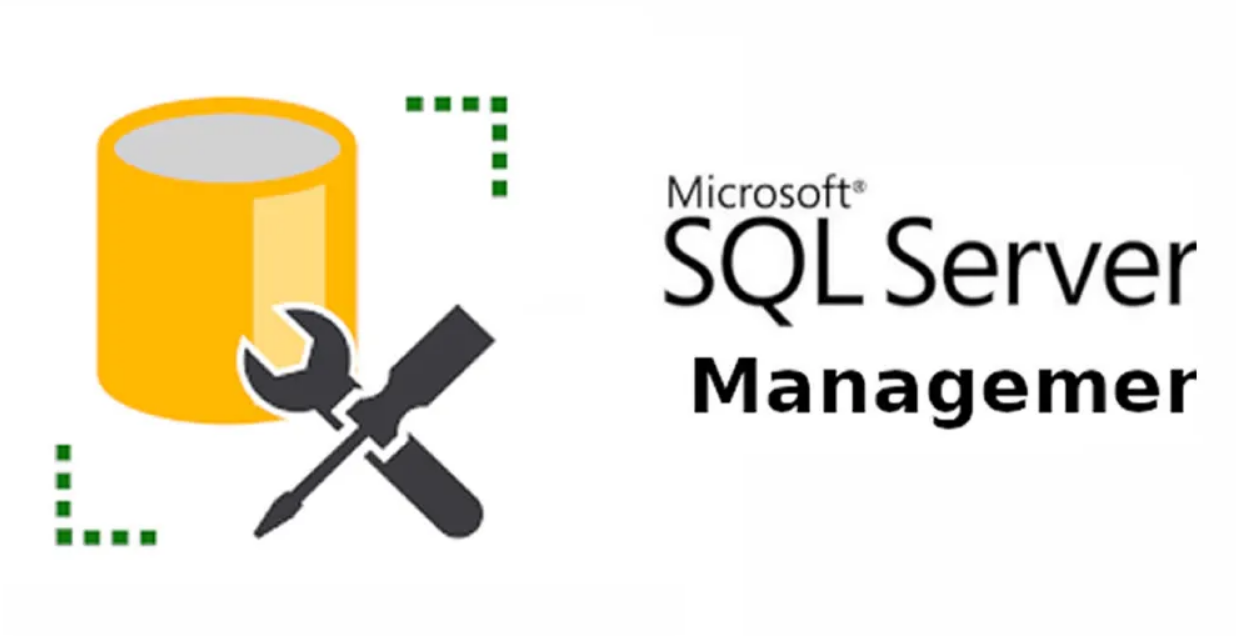
1.2 MSSQL Repair Tool
During the management of SQL Server, you may encounter corrupt databases from time to time. In such a case, a good SQL repair tool is rather important, such as DataNumen SQL Recovery:
1.3 Objectives of this Comparison
The variety of SQL Server management tools available in the market can make it a daunting task to choose the right one that suits your business needs. The objective of this comparison is to provide you with a comprehensive overview of some of the most popular SQL Server Management Tools. Each tool will be analyzed based on its features, advantages (pros), and disadvantages (cons), to help you make an informed decision. The comparison will also encompass various factors such as ease of use, scalability, cost, maintenance, and integrations with other systems. By the end of this guide, you should understand the strengths and weaknesses of each tool and be able to choose the one that suits your unique requirements the most.
2. Microsoft SQL Server Management Studio (SSMS)
Microsoft SQL Server Management Studio (SSMS) is an integrated environment developed by Microsoft for writing SQL code, managing, and administering SQL Server databases. It provides comprehensive tools that combine SQL scripting, schema, data and server management in one convenient interface.
2.1 Pros
- Comprehensive management: Being a product from Microsoft, SSMS provides access to all the SQL Server’s advanced features and management options.
- Wide-spread acceptance: Due to its compatibility with all versions of SQL Server, the tool has a significant following in the industry.
- Integration: Seamless integration with other Microsoft tools, including Visual Studio, Azure Data Studio, etc.
- Price: SSMS is free to download and use, making it a cost-effective choice for businesses.
2.2 Cons
- Learning Curve: SSMS has a steep learning curve, especially for beginners due to its complex features and functionality.
- Performance: Sometimes, users may find the tool slow, mainly when dealing with large databases.
- Limited OS support: Direct support is only available for the Windows Operating System.
- Updates: Frequent updates might come with breaking changes, causing stability issues.
3. EMS SQL Manager
EMS SQL Manager is a high-performance tool for SQL Server database development and administration. It provides an intuitive graphical interface, and comprehensive set of features that allows both expert and novice users to create and manage SQL Server databases more efficiently.
3.1 Pros
- Friendly Interface: With its user-friendly interface, EMS SQL Manager simplifies the complexity of database management and provides an efficient workflow.
- Performance Tools: It offers unique tools for optimizing server performance, managing SQL Server parameters and viewing database statistics.
- Advanced Data Manipulation: The tool supports all essential operations such as adding, deleting, editing, grouping, sorting and filtering to manage data efficiently.
- Multi-lingual Support: With its multi-language interface, EMS SQL Manager can reach to a broader audience with different language preferences.
3.2 Cons
- Price: Compared to some other tools, EMS SQL Manager may seem expensive, particularly for small businesses.
- Limited Support: Unlike SSMS, it doesn’t support all SQL Server versions, which may limit its applicability.
- Complex Features: Some advanced features may require technical experience to use, thus creating a steep learning curve.
- Customizability: Compared to other tools, it offers less flexibility in terms of customizing the interface and functionality.
4. dbForge Studio
dbForge Studio is an integrated environment for SQL Server, MySQL, Oracle, and PostgreSQL database management. Its powerful SQL formatter and multi-functional database tools are designed to improve SQL code efficiency, simplify data management, and automate recurring tasks.
4.1 Pros
- Multi-DBMS Support: dbForge Studio supports several DBMS, including SQL Server, MySQL, Oracle, and PostgreSQL, making it versatile.
- Productivity Tools: It offers multiple productivity features like coding assistance, automated formatting, and schema comparison tools.
- Data Reporting: The tool comes with comprehensive reporting functionality, making data analysis and visualization simpler.
- Security: dbForge Studio offers robust security measures to ensure data integrity and protection.
4.2 Cons
- Cost: The tool can be on the expensive side, especially for small to medium enterprises.
- Complex Interface: The extensive set of features can make the interface seem cluttered and challenging to navigate for new users.
- Learning Curve: Users might need time to understand and utilize all features efficiently.
- Customer Support: While dbForge Studio excels in many areas, some users have reported needing more prompt customer support services.
5. Beekeeper Studio: The SQL Editor and Database Manager
Beekeeper Studio is an open-source, cross platform SQL editor and database manager that offers support for a vast array of databases. It features a clean, attractive interface that allows for intuitive database management and SQL editing.
5.1 Pros
- Open Source: Being open-source, Beekeeper Studio is an excellent choice for organizations looking for cost-effective solutions.
- OS Compatibility: It works seamlessly across different operating systems including Windows, OSX, and Linux.
- User-friendly interface: Its intuitive and modern interface simplifies database management tasks.
- Multiple Database Support: Beekeeper Studio is compatible with various databases such as MySQL, PostgreSQL, SQLite, and more.
5.2 Cons
- Limited Features: As compared to more robust tools, Beekeeper Studio may offer limited features.
- Infrequent Updates: Being an open-source project, updates might not occur as frequently or as consistently as they do with commercial products.
- Support: Assistance and customer support might not be as efficient or available as with commercial database management tools.
- Performance: When compared to dedicated, commercial tools, performance might be slower or less efficient, especially with large databases.
6. Navicat for SQL Server
Navicat for SQL Server is an ideal solution for SQL Server administration and development, providing a powerful set of tools for managing SQL Server databases and executing SQL scripts, while also supporting data synchronization, data import/export, and more.
6.1 Pros
- Cross-platform: Navicat supports multiple operating systems, providing a comprehensive toolset for diverse IT environments.
- Import/Export Wizard: This feature simplifies the process of importing and exporting data to and from your database.
- Data Modeling: The built-in data modeling tool allows designing professional database diagrams quickly.
- Seamless Connectivity: Navicat for SQL Server provides seamless connectivity allowing to connect to SQL Server databases in local network and cloud.
6.2 Cons
- Complex Interface: With numerous advanced features, Navicat interface can be complex for beginners to navigate.
- Expensive: Pricing for the full-featured version of Navicat can be on the high end compared to other SQL Server management tools.
- Performance: Some users have reported occasional slowness when working with larger databases.
- Support for new SQL Server versions: Compatibility with new versions of SQL Server may take time to roll out.
7. Idera SQL Management Suite
Idera SQL Management Suite provides comprehensive tools for analyzing, monitoring, and managing SQL Server performance. It offers a complete solution focused on performance optimization, backup and recovery, security, job management, and index optimization.
7.1 Pros
- Complete Package: It offers a bundle of tools that covers a wide range of SQL management needs.
- Performance Analysis: Idera provides detailed diagnostics and predictive alerts that help in proactive management of SQL Server environments.
- Visual Display: A clear visual display of performance metrics helps in understanding complex data and system health.
- Security: It offers robust security features, including automated auditing of SQL server vulnerabilities.
7.2 Cons
- Cost: The Idera SQL Management Suite is one of the more expensive SQL Server tools on the market.
- Complex Interface: With numerous functionalities and a feature-packed interface, it can be overwhelming for beginners.
- Customer Service: Some users have reported that Idera’s customer service could be improved.
- Installation: The installation process can be complicated due to the number of components included in the Suite.
8. Azure Data Studio
Azure Data Studio is a Microsoft-developed, cross-platform database tool for data professionals using the Microsoft family SQL platforms (SQL Server, Azure SQL Database, and Azure SQL Data Warehouse). It offers a modern editor experience with lightning fast IntelliSense, code snippets, source control integration, and an integrated terminal.
8.1 Pros
- Cross-Platform: Azure Data Studio is a cross-platform tool, so it can be run on macOS, Linux, and Windows.
- Extensions: The studio supports the addition of functionality via extensions, making it easily customizable.
- Integrated Experiences: The combined scripting and querying, rich charting and visualization capabilities enhance the user experience.
- Connection with Azure: Azure Data Studio offers seamless and rapid connectivity with the Azure SQL Database.
8.2 Cons
- Limited Functionality: Compared to SSMS, Azure Data Studio has limited functionality, with some advanced features missing.
- The Learning Curve: Although the user interface is modern and intuitive, there can still be a steep learning curve for beginners.
- Immature Tool: Being a relatively new product, it is still less mature and sometimes contains bugs or lacks advanced features.
- Less Comprehensive: It does not offer as many features as some of the other, more established database management tools.
9. Visual Paradigm SQL Server Database Manager
Visual Paradigm SQL Server Database Manager is a design-first database management tool. It offers advanced modeling and diagramming tools, which can assist in visualizing complex database structures and making necessary adjustments before executing any changes in the SQL Server environment.
9.1 Pros
- Database Modeling: Its strength lies in its modeling capabilities which enable more effective database design.
- Diagramming Tools: Use of advanced diagramming tools makes visualizing database structures much simpler.
- Change Management: It allows tracking changes to the database structure, improving management of large SQL Server environments.
- Round-trip Engineering: It supports continuous modifications and synchronizations between the model and database, thus saving time.
9.2 Cons
- Limited Features: It is more of a design and modeling tool and lacks some of the full management features provided by other SQL Server management tools.
- Learning Curve: The abundance of features and a user interface more suited to experienced professionals puts it on a steep learning curve.
- Cost: For smaller projects or teams with limited budgets, the cost may be prohibitive as it tends to be higher compared to other tools.
- Performance: Certain operations may be slower when working with large and complex schemas.
10. SQLiteOnline
SQLiteOnline is a web-based SQL Server management tool that supports SQLite database management without any installations or configurations. This tool enables users to create, manage, and run SQL scripts for SQLite databases online.
10.1 Pros
- Web-Based: The tool is entirely web-based, needing no installations or configurations.
- User Friendly: The UI is simplistic and easy to navigate, which suits beginners or non-tech savvy users.
- No Login Required: SQLiteOnline allows you to work with your SQLite databases without needing to log in or create an account.
- SQLite Specific: Being tailored for SQLite databases, it handles them efficiently and effectively.
10.2 Cons
- Limited Feature Set: The tool may not offer all the in-depth management features found in more robust SQL Server tools.
- Single Database Support: SQLiteOnline only supports SQLite databases, making it less versatile for environments that use other SQL Server versions.
- Security: Being an online tool, it might raise potential security concerns, particularly when managing sensitive data.
- Dependent on Internet: Its dependency on internet connectivity might be a drawback for users working in areas with poor internet access.
11. Aqua Data Studio SQL Server Administration Tools
Aqua Data Studio is a versatile database Integrated Development Environment (IDE) that provides comprehensive database management and development capabilities. It supports a wide variety of database platforms, including SQL Server. It simplifies querying, analyzing, and managing data across different database systems.
11.1 Pros
- Multiple DBMS Support: Aqua Data Studio supports numerous DBMS, providing seamless operations across different database systems.
- Data Visualization: Its range of data visualization and analysis tools enable users to gain better insights from their data.
- Advanced Querying Features: The tool includes a powerful SQL editor with features like auto-completion, color syntax highlighting, reusable scripts, and SQL formatting.
- Integration: It provides excellent integration capabilities allowing interface with a variety of third-party tools.
11.2 Cons
- Cost: Aqua Data Studio is an enterprise solution which makes it costly for small businesses or individual users.
- Learning Curve: With its extensive range of features, it can be challenging for first-time users or those without a technical background.
- Performance: It can be slower when dealing with large volumes of data or complex queries.
- Complex Interface: Some users have reported the user interface to be complex and less intuitive.
12. TablePlus
TablePlus is a modern, native, and friendly tool for relational databases. It features a sleek UI that not only looks good but also boosts productivity, offering a very efficient workspace to manage and interact with your databases.
12.1 Pros
- Multi-DBMS Support: TablePlus has built-in support for a wide range of popular relational databases, including SQL Server.
- Modern Interface: It provides a clean, organized, and user-friendly interface which boosts productivity.
- Code Review & Safe Mode: These features make it easier to debug and reduce the risk of making destructive changes.
- Native Build: TablePlus is native built with swift on macOS, minimizing bugs and crashes.
12.2 Cons
- Limited Features: While TablePlus’s interface is clean and simple, some users might find it lacking in more advanced functions.
- Data Import/export: The data import/export process is not as efficient or straightforward as in other tools.
- Frequent Updates: The tool gets updated frequently, which can be a bit annoying for some users.
- Support: Some users have reported that customer support can be improved, particularly in terms of response times.
13. Summary
13.1 Overall Comparison Table
| Tool | Features | Ease of Use | Price | Customer Support |
|---|---|---|---|---|
| Microsoft SQL Server Management Studio | Comprehensive management, wide-spread acceptance | Moderate | Free | Excellent |
| EMS SQL Manager | Advanced data manipulation, performance tools | Easy | Expensive | Good |
| dbForge Studio | Multi-DBMS support, productivity tools | Moderate | Expensive | Moderate |
| Beekeeper Studio: The SQL Editor and Database Manager | Open source, user-friendly interface | Easy | Free | Moderate |
| Navicat for SQL Server | Import/export wizard, data modeling | Moderate | Expensive | Good |
| Idera SQL Management Suite | Database Management | Performance analysis, visual display | Moderate to Hard | Expensive | Moderate |
| Azure Data Studio | Cross-platform, integrated experiences | Moderate | Free | Excellent |
| Visual Paradigm SQL Server Database Manager | Database modeling, round-trip engineering | Hard | Expensive | Good |
| SQLiteOnline | Web-Based, no login required | Easy | Free | Moderate |
| Aqua Data Studio SQL Server Administration Tools | Multi-DBMS support, data visualization | Moderate | Expensive | Good |
| TablePlus | Multi-DBMS support, modern interface | Easy | Reasonable | Good |
13.2 Recommended Tool Based on Various Needs
While all tools bring something unique to the table, various needs dictate the choice of the tool. For comprehensive and robust management features, Microsoft SQL Server Management Studio and Idera SQL Management Suite are excellent choices.
For cost-effectiveness, EMS SQL Manager and dbForge Studio offer excellent features for their price points. Beekeeper Studio and Azure Data Studio are recommended for their ease of use and the user-friendly interface, excellent choices for beginners or non-technical users.
If cross-platform compatibility is a concern, tools like Azure Data Studio and TablePlus are recommended. Overall, you must choose a tool that best aligns with your specific requirements and budget considerations.
14. Conclusion
14.1 Final Thoughts and Takeaways for Choosing an SQL Server Management Tool
SQL Server Management Tools are quintessential for the efficient operation of your databases. The choice of the right tool, however, depends largely upon your specific needs, technical expertise, and budget. Through this comparison, an attempt has been made to provide a comprehensive overview and analysis of some of the most popular SQL Server Management Tools available in the market today.
It is important to remember that while some tools may have excellent features, they may also have a steep learning curve or may fall short on certain functionalities. Others might be easy to use but limited in their feature set or be expensive for small businesses or individual users.
Before making a decision, it is advisable to consider the tool’s ease of use, versatility, cost-effectiveness, security measures, and whether it suits the demands of your particular project or organization. A tool that perfectly balances your needs and offers great customer support when required, can significantly enhance your database management capabilities and productivity.
Author Introduction:
Vera Chen is a data recovery expert in DataNumen, which provides a wide range of products, including repair DBF product.
